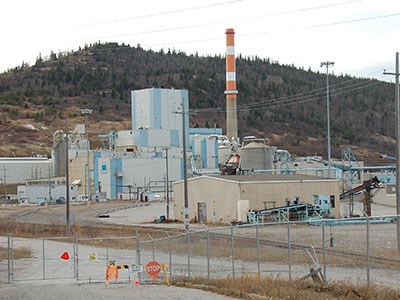The transfer of a contaminated pulp mill on the north shore of Lake Superior to a U.S. brownfield redeveloper could be completed by early next spring.
The president of the Illinois-based Green Investment Group Inc. (GIGI) said his company has reached an agreement with Tembec toward finalizing the acquistion of former Marathon Pulp mill.
Ray Stillwell said in an email that his company, Tembec and the Ministry of Environment (MOE) “came to terms that were acceptable to all parties,” at a Nov. 27 meeting.
“It is my understanding that documentation is being prepared now that will reflect that agreement. As a result, further documentation is being prepared between Tembec and our entity to reflect the modified, agreed terms of our transaction.”
Established in 2005, GIGI performs environmental makeovers on vacated and heavily contaminated industrial sites, then attracts small companies engaged in green business manufacturing such as biofuels and bioenergy.
Its first property acquistion was the Alton Steel redevelopment in its hometown, located just east of St. Louis, MO.
The company was founded and is co-owned by Stillwell, a Midwestern lawyer, and Mark Spizzo, a former economic development officer for the state of Illinois.
GIGI has made its mark in recent years by picking up former Smurfit-Stone paper mills across North America, including properties in Bathurst, N.B. and two in Quebec, at Portage-du-Fort and New Richmond.
At the Marathon site, one potential tenant is Protocol Biomass of Toronto, which has been eyeballing the North Shore mill as a site to make torrified wood pellets for export to European customers.
“We are also excited as we entertain opportunities for the site with various companies and technologies,” said Stillwell in his email, without going into specifics on his plans.
“Due to the holiday season and remaining title searches, etc., it is likely that the closing will not occur until March. Work is proceeding diligently anyway.”
A Tembec spokeswoman chose not to comment on the negotiations with GIGI and the MOE which she categorized as “ongoing.”
Lisa Brygidyr, the MOE's issues management coordinator in Thunder Bay, said ministry staff were reviewing information provided by GIGI that it "has the capacity to take over those environmental requirements."
Though the ministry is familiar with the company's track record, GIGI has "demonstrate to us that they can back up what they say they can financially provide.
“Once we're satisifed that is the case then we'll approve the sale and it can go ahead,” said Brygidyr, who was not aware of what GIGI's plans are for the property.
According to a 2011 settlement agreement, signed by Tembec, the forestry company is responsible for all known and unknown environmental issues, including the remediation.
The settlement resolved a two-year legal battle over who was responsible for the site cleanup at the abandoned mill.
Tembec, a co-owner of the mill which went bankrupty in 2009, disputed a provincial order requiring the company to be in care and control of the property.
The settlement also included a $3-million payout from Ball Packaging, another mill owner, to place a sand cap on sediment in Peninsula Harbour contaminated with mercury and PCBs from water discharged and running off the mill property.
That remediation project was finished last August.
Last May, Tembec approached the ministry to say Green Investment Group was interested in buying the property.
But for Tembec to be relieved of its obligations, the MOE has to approve the sale.
Despite Stillwell's optimism, Brygidyr maintains the ministry continues to work with the companies to “ensure appropriate measures are in place as we work through the approval process for the sale.”
Most of the outstanding issues at the mill property, which includes a landfill, involve long-term monitoring to ensure there are no unknown environmental issues and no off-site impacts.
“The mill is obviously a contaminated industrial site. As long as there's no impact, it's good to go. But long-term monitoring is how we detect if anything is changing,” she said.
“There's also the issue of the industrial sewage lagoons that are there around Lake Superior and the requirement to decommission them.”
Some chemicals spills occurred on the property in 2009 and 2010, but Brygidry said the MOE is satisified with the remediation to date and that the chemicals of concern have been removed from the property.




